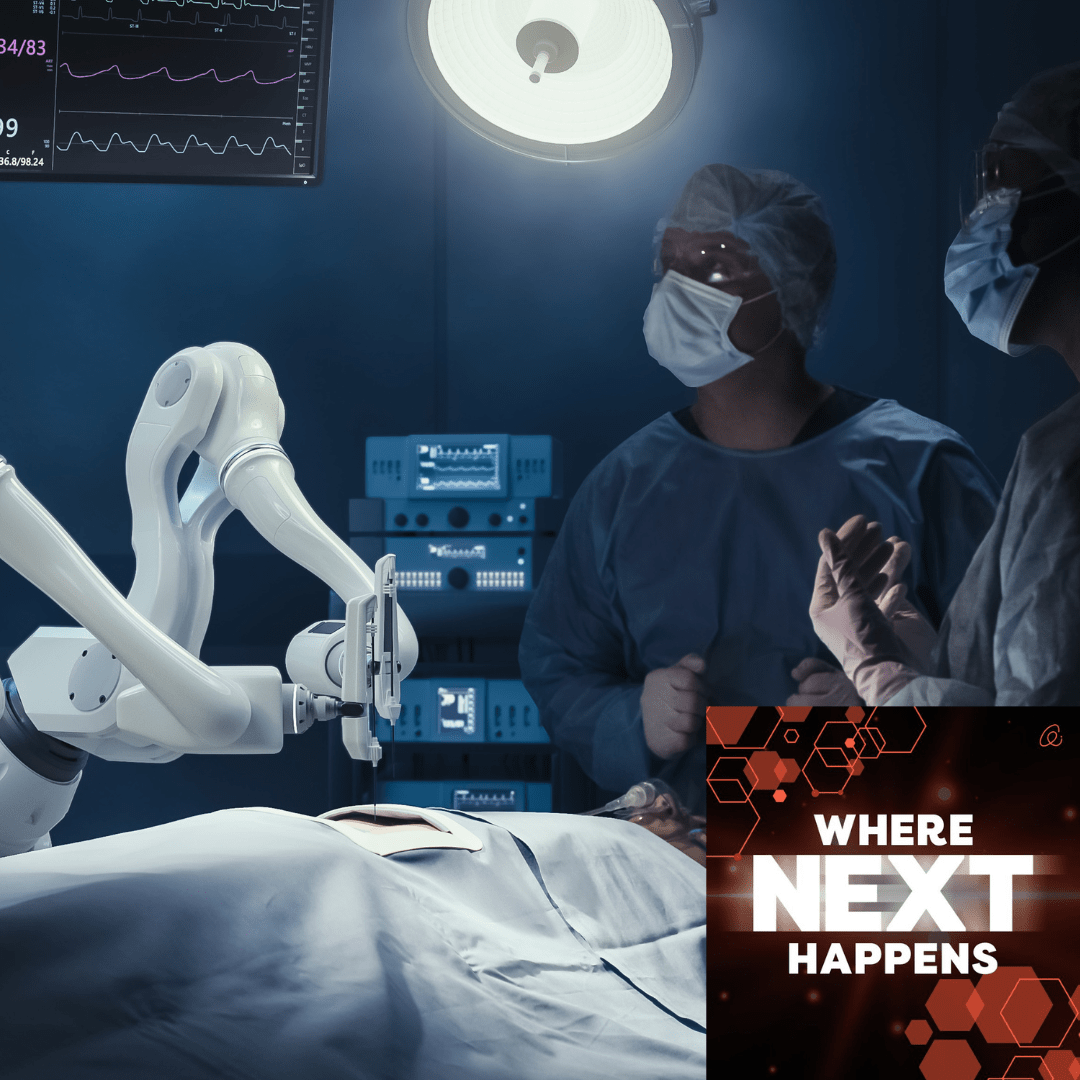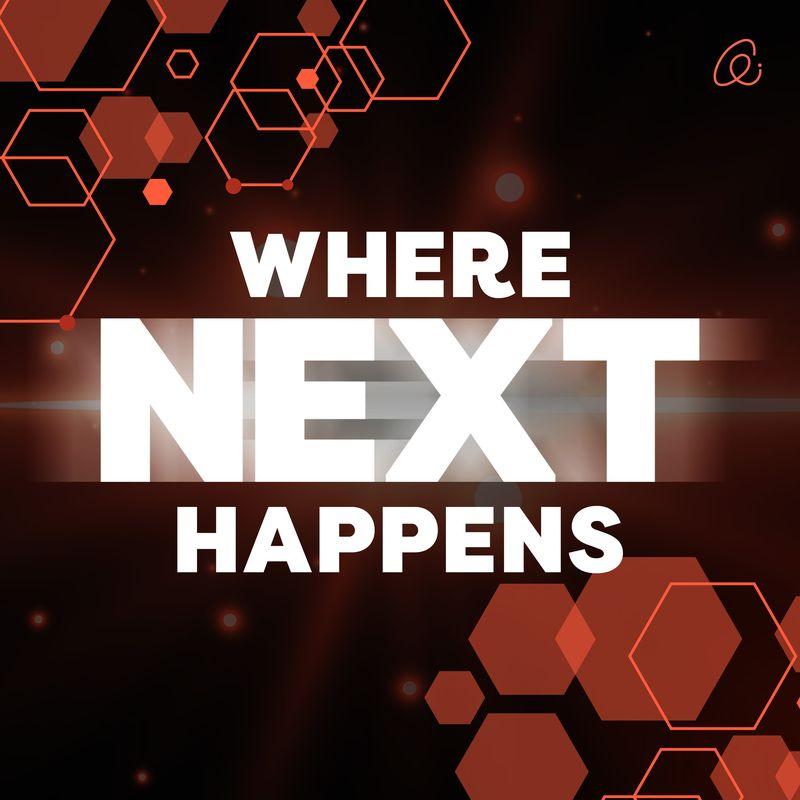
Description
Ontario’s healthcare system is facing a crisis, one that strikes at the very heart of patient care. Despite the promise of advanced medical technology, such as AI diagnostics or precision medicine, wait times for procedures remain alarmingly high. In January 2025, hip replacement patients in Ontario waited an average of 62 days. This is more than double the recommended 30-day window. For knee replacements, the wait time ballooned to 122 days. These delays raise an urgent question: Can innovation meaningfully improve access and outcomes in a system under strain?
In this episode of Where Next Happens, Dr. Claudia Krywiak speaks with Armen Bakirtzian, co-founder and CEO of Intellijoint Surgical. With a personal connection to orthopedic surgery and a passion for solving real-world problems, Armen has spent over a decade building medtech solutions designed to improve surgical precision and patient care. His company, which started as a student project, is now an award-winning medical device firm pushing for systemic change in how Canada supports healthcare innovation.
This conversation reveals the reality behind scaling medical devices in Ontario’s public system. Walk away understanding why good technology alone isn’t enough. Learn how reimbursement codes can make or break adoption. Finally, hear how one Canadian entrepreneur is working to align innovation with impact at home and abroad.
spotify
Listen on Spotify, Apple Podcasts or wherever you get podcasts.
transcript
Dr. Claudia Krywiak: We’ve seen incredible breakthroughs in healthcare, robotic surgeries, AI-powered diagnostics, and precision medicine. But despite all this progress, long wait times and inefficiencies still plague Ontario’s healthcare system. How can technology help?
Welcome to Where Next Happens, a podcast telling stories of innovators and entrepreneurs in Ontario. I’m Dr. Claudia Krywiak, President and CEO of the Ontario Center of Innovation (OCI).
Today, we’re talking about healthcare and improving patient outcomes through innovation.
According to Ontario Health, priority 2 patients who are not emergencies, but still require timely care, should receive hip replacement surgery within 30 days. However, in January 2025, priority patients in Ontario waited an average of 62 days, more than double the target. Patients waiting for knee replacement surgeries waited even longer: on average, 122 days, in January 2025, while the target treatment was only 42 days.
As a scientist by training, I’ve seen the power of innovation firsthand in the research lab. But it’s especially striking when you see it in action in the real world. I recently visited a clinic that was using AI to identify cancerous lesions, and what used to take weeks for a specialist to review could now be flagged in seconds, helping patients get care faster and with greater accuracy.
Like many people, I’ve had family members face delays in diagnosis and treatment. That’s why I believe so strongly in the role of technology, not to replace care, but to make it faster, more accurate and more accessible. It can make a real difference when it matters most.
There’s a company making real strides in healthcare innovation: Intellijoint Surgical. What started as a capstone project at the University of Waterloo has grown into an award-winning medical technology company that’s transforming joint replacement surgery worldwide.
Today, I’m joined by Armen Bakirtzian, Co-Founder and CEO of Intellijoint Surgical. Armen leads the company’s growth and strategic partnerships, while championing Canada’s medtech industry through initiatives like the Medical Innovation Exchange: Canada’s first industry-led hub, dedicated to helping medtech companies scale at home. Under Armen’s leadership, Intellijoint Surgical’s flagship product, Intellijoint HIP, has helped surgeons perform thousands of more precise hip replacements for patients around the world.
Welcome to the podcast, Armen. Armen, you and I have known each other for quite a while, and OCI has known Intellijoint for a very long time. But why don’t you take us back to the beginning? Most people interested in medicine usually end up going to medical school, but you opted for medtech instead. Tell me about that decision.
Armen Bakirtzian: Sure, I’m happy to. Claudia, it’s always nice to speak to you, and to see you, and chat about entrepreneurship and Canada, and just the overall potential that we have as a nation.
I agree, a lot of people, especially with physicians as parents, tend to follow in their footsteps, or at least have the pressure to follow in their footsteps. In my story, I was fortunate to have access, not only to an orthopedic surgeon in my father, but also the environment where orthopedic surgery is completed. Of course, I was interested in medicine. Actually, I even applied to medical schools.
Dr. Claudia: I did not know that.
Armen: Yes, only the medical schools that did not require the MCATs. My instruction was very limited.
But at the end of the day, I’m happy I didn’t get in, because I followed the path I was supposed to be on, which is entrepreneurship in the medical technology space. I came as close as I could to orthopedics without necessarily being on the scrub side and caring for the patient. But caring for the surgeon is really what we try to do.
What we try to create are solutions that respect orthopedic surgeons: the practice they are trying to create, the care they are trying to deliver for their patients, and the life they are trying to lead as well. They’re all human at the end of the day. They have job pressures. They have personal pressures. Everybody wants to get home on time. They don’t want to belabor for anything that doesn’t need to be belabored. Nobody wants extra complexity where it’s unnecessary.
Those are the things that go into our mindset when we try to create solutions for orthopedic surgeons.
Dr. Claudia: How did the idea for Intellijoint come about? What problem were you trying to solve?
Armen: It’s a great question, Claudia. Problem solving is the name of the game. One thing I try to advocate for is exactly that: find a problem to solve. For us, the problem was quite clear.
Orthopedic surgeons doing hip and knee replacements rely on their training and their judgment. Obviously their training is extremely robust and their judgment is quite sound. But at the end of the day, they’re human beings, like I said before, and they make mistakes.
It’s very difficult to orient implants in a very specific position or orientation in the body. It’s very difficult to pick the exact size that’s going to make sure that the patient walks like they used to, or better than they used to. It’s very difficult to create these types of improvements for patients, especially without the use of technology.
How does their overall spine impact how they walk? These types of things are important inputs to decision making that orthopedic surgeons need to do. Technology is a great way to introduce some of these complex things into their overall practice.
To answer your question, we learned about the problems from customers, from surgeons, from actual people living this stuff, day-in and day-out. My unfair advantage is one of them happened to be my father.
Dr. Claudia: What were some of the challenges that they were facing in routine surgeries?
Armen: Orthopedic surgery is difficult. Hip and knee replacement is a historically very successful procedure. It provides relief of tremendous pain for people that have really had to endure this pain for a long time. These are the opportunities to give people relief from pain.
The problem associated with hip and knee replacements is surgeons generally place implants using their training, their judgment, and sometimes they make mistakes. They can place the implant slightly in the wrong position or pick slightly the wrong size. Ultimately, that would lead to dislocation of a hip replacement, or lead to a leg being too long or too short, or lead to dissatisfaction in the knee replacement, for example.
Orthopedic surgeons wanted to improve these things. However, orthopedics, and hips and knees in particular, is a high volume procedure. You have to respect that orthopedic surgeons and health systems need to do a lot of these surgeries.
Not only is the information provided to these surgeons really important in terms of the accuracy of the information, but also it cannot disrespect their environment. It needs to be fast, it needs to be easy to learn. It needs to be easy to use. It needs to provide surgeons information without forcing them to change their workflows, without forcing them to change their implants that they’re using, and all of these types of things.
The problem is actually quite complicated and multifactorial. It’s not just, we want to provide surgeons with accurate information, which is, of course, the foundation of what we need to do. But it needs to be respectful in the environment in which they’re operating.
Dr. Claudia: You had a problem that you were trying to solve. You had a very good firsthand understanding, through your father and also through your network, of the challenges that surgeons were facing. How did you go from concept to real world medical device? What did those early prototypes look like?
Armen: It’s always a journey, right? It can be intimidating to think about. How do I go from a problem statement to an actual kind of product, right? It’s like everything else. You take it one step at a time. One bite at a time. Really surrounding yourself with people that will guide your journey was super important for us, and I suspect, very important for others.
It all started from learning from actual people of what their challenges were. These were orthopedic surgeons for us doing hip and knee replacements. Not only did we learn about the opportunities of improving the accuracy of the surgery, but we also learned the things I mentioned. In terms of the product, it has to be fast, easy to learn, easy to use. Those types of things. Those were, what we would call, kind of our design requirements.
Those requirements actually led us to create a new technology. Because when we put all these requirements together, and we looked at the technology landscape across the field, none of the technologies that we encountered were sufficient to achieve our design requirements. That led us to create our own core technology, which is quite novel and quite unique.
Surgeons have been there with us every step of the way. Not only identifying the problems for us, but helping us filter our solutions. Because you can solve a problem in a multitude of different ways, but it’s really the integration, or the ability to integrate the solution into the environment in which it needs to be successful is ultimately, kind of the name of the game.
Keeping those surgeons involved throughout the iterative design process was really important for us, and that helped us refine what we were trying to build. Then once you have a better idea of what you’re trying to build, you can actually upgrade your company, if you will, to a medical device company. Then run a prototype, or a near finished prototype through a quality controlled environment. In our space and medical devices, you can live and operate in a controlled environment or an uncontrolled environment.
Ultimately, if you’re going to put a product on the market, you need to operate in a quality controlled environment. Creating your prototypes outside of the quality control system can let you do things quickly.
Once you have, what we would call, a product market fit, or a technology that’s suitable to solve the problems of your customers, you can get what’s called the ISO 13485 certification or quality management system within your company that will outline the steps that you need to follow in order to create a safe and effective medical device.
It’s one foot in front of the other. You’re going to work outside of a quality controlled environment for as long as you can. You’ll turn on your quality management system, which I would suggest you borrow from somebody else. Then you run your “product” through that quality management system and ultimately, land at a product that gives you a chance of getting approved by the regulator.
Dr. Claudia: Can you give us a sense of the timelines for something like that, going from concept to minimum viable product, to a functioning prototype, to ISO certification?
Armen: It can be done quickly. As first time entrepreneurs, Claudia, we went from winning the Ontario Next Top Young Entrepreneur Competition in May of 2010, to our first live surgery in Canada as an ISO 13485-qualified medical device company, with a Health Canada Medical Device license. We did that in December of 2013.
Dr. Claudia: Oh, wow.
Armen: It took us two and a half years.
Dr. Claudia: That’s impressive.
Armen: It’s fast, right? We’re a Class II medical device. Everyone tends to give Health Canada a hard time. I’m not one of those people. We got our Health Canada Medical Device License in two weeks, which is what you would expect for a risk category of our type. You follow the rules, you get your license. I think it’s been that straightforward, for us at least.
But we were really fortunate to work with people that had done this before. Myself and my co-founders were all first time entrepreneurs. But not only were the surgeons around us very fantastic at the top of their game, we also met product development engineers. One in particular that had done this before.
One of the things that really helped us out, in a big way, was with investing or fundraising. We did a good job of telling people what we were going to do. Then we did what we said. That gave us a lot of credibility as young entrepreneurs, to say something that we were going to do, and then do something that we said. That just lends us a lot of credibility that just helped us along the way.
Dr. Claudia: Let’s talk a little bit about some of the hurdles in getting the Intellijoint technology from concept to reality. What were some of the challenges? Were there moments where you thought it might not happen?
Armen: I think every entrepreneur has these stories. Challenges are countless. You can pick on the easy ones, which is access to capital and those types of things. That was a challenge for us, just like everybody else.
I would say, we had a bit of an advantage there, Claudia. Generally, we’re raising money from people that are later in life, who know somebody who’s had a hip or knee replacement. Whether it went well or went poorly, whatever it is, it was relatable. That made it easier for us to raise capital.
But it was very difficult in the early days, especially because there was a single track of success. You learn that through osmosis as an entrepreneur. We celebrate big financing rounds, we celebrate acquisitions. Those are the things that we celebrate as an ecosystem. As an entrepreneur, you kind of get conditioned to follow a similar path.
I would say our largest challenge, Claudia, was learning that, “Hey, we can actually do things differently.” It requires us to build our company in a different way. That is different from the very popular approach of being an entrepreneur in Canada. I would say, fundamentally, if you kind of take away all of the “easy” challenges of access to capital, access to customers, and those types of things, access to talent, it’s really building our business to be a sustainable, long term successful business in Canada, has been the hardest challenge we’ve had to overcome.
Dr. Claudia: Let’s talk a little bit about that, about building a successful and sustainable business in Canada. When you’re in the healthcare sector, where your customers are in the public healthcare system in Ontario and Canada, and where the early adopters and the first customers in that sector, invariably, always come from outside of Ontario and outside of Canada.
Can you talk a little bit about the unique challenges of selling into the Canadian healthcare market, particularly when it comes to healthcare procurement and reimbursement? What does that mean for a company that wants to be successful, and sustainable, and grow, and stay in Canada?
Armen: We were fortunate to have a lot of orthopedic surgeons surround us. I mean, 12 orthopedic surgeons were in Kitchener Waterloo. We had 12 surgeons helping us all within an hour of Kitchener Waterloo. From London, to Hamilton, to Toronto. Fantastic group of orthopedic surgeons. They blazed the trail for us in many different regards, especially when it came to using the product for real in a live clinical setting.
After we got our Medical Device Licenses, we wanted to make sure that the product worked in surgery as we intended it to, and that went great. We weren’t charging the hospitals anything, so we had no hurdles, no roadblocks. But after the successful completion of those “pilots”, and the surgeons wanted to continue using the product, we can continue to offer it for free. That’s when all the roadblocks came up.
Ultimately, we had to take our stuff, our equipment, out of all of the hospitals where our designer surgeons practice, which was just a really terrible day, a terrible situation for us. Fundamentally, the challenge in Canada is that we pay for procedures, we pay for a service. In Canada, we don’t pay for an outcome. If somebody goes for hip or knee replacement, whether it goes poorly, it goes great, or anything in between, the fee for the physician, for the hospital is the same.
God forbid, something happens to that patient, they need to come back the day after for a corrective surgery that would cost tens of thousands of dollars. There’s a separate bucket of money that pays for that. There’s really no skin off the hospital’s back, because it doesn’t really impact their finances too much. Really, the challenge for any company, that hurts a financial situation to improve a clinical situation, is in a tough spot, especially if you are trying to position yourself to the hospital and not to the system.
I’ll give you an example of why that matters. In a hip or a knee replacement, a surgeon using their training or judgment to select in place implants, it’s free. They use their eyes, they use their training. It doesn’t cost the hospital anything for that.
Then Intellijoint comes along and says, “Hey, we can give you better information. This information can be used to improve the outcome of your patient.”, “Great. Well, how much does it cost?”, “It costs x.” X is greater than nothing. That’s tough. “Hey, by the way, Intellijoint, can you save me money while the patient is still under our roof?”
A hip replacement or a knee replacement, they’re gone in a day or two. They’re not going to need a revision or a repeat surgery within a day or two, unless you did something catastrophically bad in the surgery. “Sorry, Intellijoint, you make that patient’s life better, and maybe they won’t come back for surgery in six months, a year or two years. But you’re not really saving me any money, as the hospital, Intellijoint, I can’t give you any business.”
Really, that’s the long and the short of it is. Without any additional funds that the hospital is receiving for integrating technology or a solution, like Intellijoint, into the surgery, then the hospital is handcuffed. They have no more money. They’re already operating at a loss, and to spend more money to prevent a patient from coming back to the healthcare system is not an investment they can make.
It really requires the system itself to be making those investments, no matter where the solution is being adopted. Intellijoint Solution is adopted in the hospital. The system is expecting the hospital to foot the bill for our technology, such that this system overall can reap the rewards. It just doesn’t work like that. We need to align incentives across the healthcare system.
Saving $1 for the system is good for all, and hospitals should be motivated financially to save the system money, not just motivated to try and deliver the best possible care for their patients, which I think everybody has an inherent motivation to deliver the best possible care for the patients. Sometimes the financial incentives don’t align with that.
Dr. Claudia: Do you see an opportunity for change, an opportunity to move to a model that would see an increased focus on improving patient outcomes? Or realistically, are entrepreneurs in Canada that are developing innovative technologies where the primary market is the public healthcare market stuck with these challenges?
Armen: It’s an interesting question, Claudia. I wouldn’t be here if I didn’t think that there was potential for change. We’ve been around for a long time, at Intellijoint, we’ve been on the market in Canada for 10 years. We’ve run into countless roadblocks on how to be successful in Ontario and in Canada.
Ultimately, where we’ve landed is, without the creation of new reimbursement codes, we’re not going to be in a place where any of our technologies are going to be adopted at home. The solution is through the creation of new reimbursement codes in Ontario and across our great country.
It’s really the absence of that, will leave us where we found ourselves in the last 10 plus years, which is in a mode of constant pilots. We get some funding to do a pilot at a particular hospital. That hospital thinks it’s great, but there’s no way to get to the other hospitals and that’s what we’ve done in our country. We’ve created a lot of programs that fund pilots but don’t fund scale.
Ultimately, it’s because there’s no reimbursement to support financially the adoption of a product or service at scale across the province. It’s the creation of a pathway to earn a reimbursement code that is what I’m really excited about. There is a pathway that has been built here in Ontario to test products or services against the criteria of clinical benefit and economic benefit to the system.
Such that you can get awarded a new reimbursement code, such that all of the hospitals or wherever your product or service is delivered. The reimbursement code from the province will eliminate any financial burden on that particular account, whether it be a hospital or something else. Its removal of that financial burden through the creation of reimbursement that will unlock the adoption of Ontario made medical technologies, products or services, that serve the healthcare sector.
Dr. Claudia: For listeners, some of whom may not understand how reimbursement codes work, can you just explain why they’re important, what happens now, and what actually needs to happen in order for there to be reimbursement codes for new and innovative technology?
Armen: Yeah, it’s a great question. Reimbursement, it can be a little bit of a pickle, but, as the name suggests, it’s a reimbursement. Money comes back to, let’s say, a hospital for delivering a product or service. The way a hospital works is it delivers a product or service to a patient, and then it gets paid back by the government through a reimbursement code for delivering that product or service.
If it delivers a product or service that does not have a reimbursement code attached to it, then the hospital is on the hook to, essentially, eat the cost to deliver that product or service. Because the government has said, “Hey, this is not a product or service that we pay for. If you want to deliver that product or service, hospital, you’re more than welcome to. We’re just not going to give you any money for it.”
That’s fundamentally, and very basic words, that’s how our healthcare system operates through a mode of reimbursement. If there is no pathway to create new reimbursement codes, then hospitals will have no incentive to change their behaviors. They’ll continue doing what they’ve always done.
Dr. Claudia: It seems very clear this is a fundamental issue that needs to be addressed. Notwithstanding the various pilot demonstrations that occur in hospitals, if there is no pathway to reimbursement, there is no incentive to drive the adoption of this technology. This is not an easy space to do commercialisation in. Based on your journey, what advice would you give to other innovators that are looking to break into medical devices in Canada?
Armen: It’s a great question. One that’s, maybe the response is a bit weird, because it is such a challenging space. It’s such a challenging geography to launch a medical technology company.
A logical person would say, “Why do it at all? This makes no sense.”
However, I’m an engineer. I like logic, at the same time, there’s something extremely special that happens when a person benefits from a technology, or something that you’ve made. What a great feeling to know that the blood, sweat, and tears that you’ve poured into your thing, whatever your thing is, has made somebody’s life better.
It prevented them from needing repeat surgery. It helped them play with their grandkids, or go back to work, or feel like they had value in their life. It’s something that’s really special in orthopedics. I know this is why my dad was so attracted to it. I know this is why a lot of orthopedic surgeons are attracted to orthopedics. You can fix somebody in an instant.
Somebody comes in because they cannot walk, because they’re in so much pain. Then sometimes that afternoon, they walk out of the hospital, and they go home. Just to be a part of that story is so rewarding. I know it’s what drives us day-in and day-out. It’s what drives us to break through the challenges at home.
Canadians are the ones that have funded the creation of our company. We got an $18,000 loan from OCE at the time, and that money wasn’t yours. Maybe it was partly mine. I don’t know if I was paying taxes at the time, but it’s taxpayer funding. It’s taxpayer funded money. Why shouldn’t Canadians benefit?
I should put it a different way. It’s a shame for Canadians not to benefit from the technologies, especially in healthcare, that they funded indirectly as taxpayers. To be able to help Canadians that have made a bet on us is something that just drives us. I can’t stand here knowing that our products are not used in Canada or in a very limited fashion, and just accept that as reality. It just doesn’t fly.
We’ll do what we need to do to break through in Canada and Ontario, and be successful, and deliver value to Ontarians and to Canadians. Because they are one of the major reasons why we exist.
Dr. Claudia: Your advice would be perseverance and resilience to entrepreneurs in this space, because ultimately, it’s worth it to be able to unlock that innovation to benefit Canadians.
Armen: Totally agree, and sorry for not answering your question directly. There’s something I’m clearly passionate about, Claudia. I would totally agree, perseverance. It’s a flavor of doing the right thing.
You’re educated in Canada, if you are, start your business in Canada, and to keep it in Canada, in my opinion, is the right thing to do. We’ve got a lot of potential in this country to do great things there. It’s very easy for entrepreneurs to leave Canada, and sometimes, unfortunately, it seems like it’s encouraged by the government.
But as best people can to fight those trends, to dig your heels in, put your roots here in Ontario and Canada, to start your venture here, you can do it here. You can do it hugely successfully from here. I wouldn’t really agree with anybody that tells you otherwise. I think Intellijoint is living proof of that.
Dr. Claudia: Let’s talk a little bit about your biggest market. If you look at the US healthcare market, it’s worth over $5 trillion annually. Just to give our audience a sense of how large that is, that’s more than India’s GDP. That’s just the healthcare market in the US.
Right now, the relationship between Canada and the US, especially as it relates to trade, is quite tense. The trade relationship that we have with the US, can you talk a little bit as a company that has a significant presence in terms of its customer base in the US? What kind of support do companies like Intellijoint right now need most, given what’s going on, and what could potentially happen if there isn’t a negotiated agreement that is beneficial to Canada?
Armen: Yeah, Claudia, it’s been a weird five, six years, we’ve had to go through as an industry. If it’s not a pandemic, it’s inflation. If it’s not inflation, it’s trade wars and tariffs. It definitely keeps us on our toes.
I think to answer your question directly, what companies like Intellijoint need is clarity. We need stability, which is hard to come by. I think if the last, however many months it’s been now, five months, is an indication. I don’t know if you’re going to get that clarity or if you’re going to get that calm, or if it’s just going to be chaos, kind of month after month.
To be honest, it’s quite exhausting to try and keep up with all of this. My advice would be, and this is what we’ve done, if you’re not getting that sense of calm and predictability from the external environment, try and create it for yourself and then ignore the external environment.
With trade, it’s all about when goods cross the border. If you’re uncertain what that’s going to be like, and you have control, just move stuff across the border in a greater volume than you have historically, and just let the stuff play out. That’s what we did. We moved a bunch of inventory down to the US, and we kind of put our head in the sand when it comes to trade talk, which is quite soothing and relaxing to ignore it for a little bit.
As a medical device company, we’re exempt under USMCA. However, that was not always the case. Everything’s gonna get tariffs. Doesn’t matter if you’re part of any trade deal or whatnot. We took the approach of let’s move inventory and let things calm down. If there’s a window where things are calm and we can continuously improve our situation, that’s what we’ll do. That’s what we’ve done, in terms of what we could do proactively.
Other than that, diversification is the name of the game. I think for a lot of us, we’ve put a lot of our eggs in the US basket. We won’t take eggs out of the US basket, but we will add eggs in other baskets. Whether that’s Intellijoint pushing itself to other international markets or international markets reaching out to Intellijoint. Maybe they don’t want to deal with US companies either, because things are uncertain, not only for us, but for everybody.
I think it’s a double edged sword. You can control what you can control, and if you’re not getting the control you need through external factors, try and get it yourself through internal factors and diversify away from the problem child, if you will.
Intellijoint has done a good job, in my view, of diversifying, but also supporting the US business. Our makeup of revenue hasn’t necessarily changed or anything like that. The US market is still a great market, if not the best market, for medical device companies. Whatever you can do to manage the changing environment where you need to be successful. I think that’s time well spent.
Dr. Claudia: Can you talk about the importance of collaborations and partnerships, especially when we’re talking about the types of support that entrepreneurs need on their journey?
Armen: Of course, Claudia, and there’s a saying, right? It takes a village to raise a child. That’s definitely true when it comes to entrepreneurs, and entrepreneurship, and the companies that we try and nurture. Partnerships are critically important.
Intellijoint started because of relationships and partnerships between my co-founders, my dad, other folks that had knowledge in the industry. That continued when we went to the Accelerator Center in the RMT Park, just north of Waterloo Campus. Partnerships were always really part of everything that we did and that continued.
Obviously for us, OCI or OCE, was a big partner early on. We wouldn’t have gotten our start if it wasn’t for OCE and the original funding that we got, which introduced us to folks that we would call partners after. In angel groups, hospitals, networks, and things like that. To foster the ecosystem, to create more entrepreneurs is really important. To create an ecosystem where they will find success across their life cycle is important.
That team of partnerships has evolved for us. So much so that we saw an opportunity in this region to come together and create, what we call, MIX, the Medical Innovation Exchange, that supports scale up founders in the medtech space to find commercial success globally, while keeping their headquarters and their roots firmly planted in Ontario and in Canada.
Through partnerships with OCI and others, this allows us to, not only create new companies, but to retain those companies in our community, in our ecosystem, to keep this know-how here. Such that we can pay it forward and pass it along to the next generation of entrepreneurs, who’s trying to create something novel, or whatever it is. Those partnerships are foundational across the region. Here, in particular, with the University of Waterloo, with WRHN, the Waterloo Regional Health Network.
Ultimately, we have a big job in front of us. We talked about reimbursement, and it’s not easy to create reimbursement codes. It’s not easy to create pathways to generate new reimbursements. Its partnerships across the entire ecosystem, with the province and with governments that will, ultimately, move the needle in the right direction.
You can’t do anything on your own. If you want to go far, go together. It’s partnerships that will strengthen the pitch, strengthen the value proposition. Ultimately, create the community that will yield successes for intelligent and many other intellijoints in the future.
Dr. Claudia: As we wrap up, what’s next? Where do you see the biggest opportunities for not only growth, but transformation and healthcare technology?
Armen: Yeah, it’s a great question, Claudia. What’s next for us is continuously growing our business, and getting to every patient, and every surgeon. That’s our mission as a company. Doesn’t matter to us, where you are, who you are. We want to help you.
If you’re a surgeon, we want to help you deliver the best care to your patients. If you’re a patient, we want you to get the best care possible. Control of our destiny is important to us, and continuously growing our business is important to us. Thankfully, we’ve been able to achieve both.
We’re growing at a meaningful rate within our business. We’re growing internationally. We’re adding new products to the portfolio. We’re charging ahead in a variety of different aspects, not only in new technology creation, but also in geographic expansion.
You mentioned India. I was in India two weeks ago, and we launched in that country, for the first time, and did our first live surgeries there. The value proposition of Intellijoint is true, and it rings true wherever you go in the world. Ensuring we get our products and services to everywhere in the world is important to us, and always continuously innovating.
That innovation comes across what we would call “the episode of care”. An actual surgery is a point in time, but there’s a lot that goes ahead of surgery, and there’s a lot that comes after surgery. If you can connect the dots across an episode of care, and use learnings from the past to influence the care that you deliver to all of your future patients, I think that is how you’re really harnessing the knowledge, the know-how that is generated from every episode of care to then benefit every future episode of care.
Understanding what you’re doing to every patient, understanding what outcome does that patient achieve, and then how you would use those learnings from that patient to influence change or keep the same treatment pathway for the next patient. I think that’s an area that’s super interesting.
Obviously healthcare is extremely rich in data, and there’s a lot to be done. Generally, healthcare is laggards when it comes to technology. It’ll be interesting. In the next 10 years, will we catch up to the rest of the technology world, and surpass, who knows. I think it’s the dawn of integration of technology in the medical world, and I think the pace of adoption is going to increase in a meaningful way. We’ve seen that in our own business.
When we started in 2010, believe it or not, only 3% of orthopedic surgeons used any technology to put into the hip or knee implant. Now it’s better, but it’s still around 20%. There’s a lot of room to run. I’m just super curious on how the integration of technology will play out and maybe, to tie it back to the first comment of being respectful of the environment in which our technology solutions need to thrive, is the name of the game.
Healthcare professionals are busy. Everybody’s busy. But I think they have an extra layer of busyness that I haven’t really seen in other sectors. People’s lives are on the line. They want to be thoughtful with decisions that they make, and need to be very considerate of different solutions that they put into the care for their patients. But I think the next 10 years are going to look a lot different than the last time.
Dr. Claudia: Armen, thank you so much for sharing your commercialisation journey with us and talking to us about the Intellijoint technology. As you said, the last five years have been rough. They have been rough from, first, the pandemic, then the economic headwinds, and now the geopolitical uncertainty and the trade challenges, but entrepreneurs like yourself have persevered.
What is really incredible in listening to your journey is, not only your resilience, but how excited and committed you are to having an impact on improving people’s lives. In this sector, for medical device entrepreneurs especially, while it can be tough, the rewards are really tremendous.
Thank you so much for sharing your journey with us. As always, it’s a pleasure to speak with you.
Armen: The pleasure was mine, Claudia. Thanks so much for having me.
Dr. Claudia: That’s it for this episode of Where Next Happens. To learn more about Armen’s innovative work, visit https://intellijointsurgical.com/.
Where Next Happens is produced by the Ontario Center of Innovation. This episode was produced by Jasmine Rach and edited by Gaetan Harris. Amanda Cupido is the executive producer, and I’m your host, Dr. Claudia Krywiak.
Ready to take your idea to the next level? The Ontario Center of Innovation helps innovators access the funding, mentorship and resources they need to drive the future forward. Visit oc-innovation.ca to learn more. We are a newly launched podcast, and we’d love to scale. If you liked this episode, please share it with your peer who’s also inspired to innovate.
Subscribe for program updates & more
Subscribe and receive updates on programs, events and Ontario’s innovation news right to your inbox






